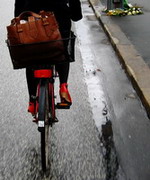Pedal Power
 Leg speed translates into pedal power and it’s known as the ‘cadence’ or rate at which a cyclist turns the pedals per minute. If your leg speed is not tuned to the road ahead then neither are you. Over a distance if you pedal lower than the 60 to 80 revolutions per minute (rpm or cadence) you will quickly tire out.
Leg speed translates into pedal power and it’s known as the ‘cadence’ or rate at which a cyclist turns the pedals per minute. If your leg speed is not tuned to the road ahead then neither are you. Over a distance if you pedal lower than the 60 to 80 revolutions per minute (rpm or cadence) you will quickly tire out.
Climbing steep hills or cycling into a head wind will slow you, and most likely will decrease your cadence, so this is why you need use your gears to keep up the right rpm. The way your foot makes contact with the pedals also affect your available power. Don’t tip-toe on the pedal or force your heel down; keep the ball of your foot over the axle of the pedal.
For more power fit toe clips with straps to your pedals so that every time your foot is on its upward sweep, it can assist the other foot which is pushing down.
 Advanced cyclists wear shoes with cleats in the sole that keep the foot in the right position and gives them an even more effective dragging action on the upward sweep of the pedals. Some coaches make their charges pedal with just one foot to teach the importance of using the correct amount of upward foot motion.
Advanced cyclists wear shoes with cleats in the sole that keep the foot in the right position and gives them an even more effective dragging action on the upward sweep of the pedals. Some coaches make their charges pedal with just one foot to teach the importance of using the correct amount of upward foot motion.
 Not all cycling shoes are like those of the “road racer”. These days there is a wide range of urban cycling footwear that looks like and walks like normal shoes – with the added advantage of having inbuilt cleats that make cycling a joy.
Not all cycling shoes are like those of the “road racer”. These days there is a wide range of urban cycling footwear that looks like and walks like normal shoes – with the added advantage of having inbuilt cleats that make cycling a joy.
Other pedalling tips: Wear hard rubber-soled shoes so you don’t get sore feet; change gears early and often so you don’t have to pedal too hard and point the toe of your foot slightly inwards.
News & Info Sections
-
News
(38 items)
-
Information
(30 items)
-
Tips
(18 items)
-
Offers
(2 items)
-
Ideas and suggestions
(13 items)
-
Headlines
(25 items)
-
Ride to work
(20 items)




